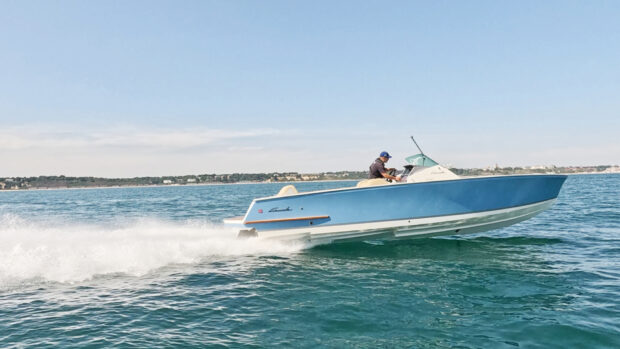Knowing how to throttle and trim a planing boat correctly is a key skill, especially for owners of smaller, faster craft like RIBs and sportsboats. Our resident boating instructor Jon Mendez explains how it's done...
The first thing to sort is your driving position. At speed, the relationship between the wheel and throttles becomes crucial and it’s imperative, especially in smaller boats, to keep control of them even when being bounced about.
Your seating position is vital too: you need to be stable but relaxed so that you don’t accidentally move the controls. Lastly, the single most important item is the kill cord, this needs to be attached as soon as the engine is running.
When speeding up, the actions required are similar in any sea direction. What does differ is how you trim the engine and any trim tabs fitted to the boat.
The first step is to have a good look round to ensure it’s clear, then with the helm straight, the engine trim in the fully down position and the tabs up, engage ahead at tick over.
Now progressively push the throttle forward so that the boat starts to increase speed. As the bow rises, add more throttle until you are fully planing.
You don’t need to go that fast – many craft will plane at 15-16 knots. I find 20 knots a safe, sensible speed to practise at. When at a steady planing speed, trim the engine up slightly, usually for around two seconds – you will hear it, see it on the trim gauge and the tachometer will show the revs rise a small amount and the speed increase.
This is because lifting the bow means there is less boat in the water and therefore less drag. If you are running into the waves, you may want to reduce the trim to keep the bow down so that the sharper forward part of the hull is cutting through the chop rather than slamming into the waves with the flatter aft section.
If you have trim tabs fitted these can also be lowered to raise the stern and push the bow down even more. An easy way to remember this is: upwind, bow down.
Article continues below…

VIDEO – How To: Helm in a beam sea
In our latest How To guide we demonstrate how to trim your boat if you are travelling in a beam

VIDEO: How to – Head to windward
In our latest boat handling video, Jon Mendez shows how best to trim the boat when you head to windward
Conversely when going downwind, you want the bow up and out of the water so you don’t stuff it into the back of the next wave as you overtake the previous one.
Trim the engine up and lift the tabs; don’t lift it too high, though, as this may cause the boat to porpoise. This time, the phrase to remember is: downwind, bow up.
To slow down, check there are no boats coming up fast behind you then trim the engine back down as you bring the throttle back towards tick over.
Keep it progressive, though – if you slow too quickly your stern wave may catch you up and flood the transom. Once the stern wave has dissipated, go back into neutral.
If you enjoyed this…
Be first to all the latest boats, gadgets, cruising ideas, buying advice and readers’ adventures with a subscription to Motor Boat & Yachting. Available in both print and digital formats, our monthly magazine will be sent directly to your home or device at a substantial discount to the usual cover price. See our latest offers and save at least 30% off the cover price.










